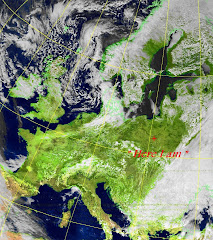 |
| MakerHawk GPS 51 receiver with active antenna |
For convenience ( least effort ) rather than a good view of the sky, ( which there certainly wasn't ), I positioned it close to my laptop ( in fact on top of the printer ) in the centre of a room far from two small windows, connected it to the laptop via a usb to uart serial converter, and opened a serial terminal program.
I doubted if there would be enough satellites received in that position; but after just a few seconds "NMEA Sentences" were being streamed every second and a position fix given. I was absolutely amazed !!
 |
| (L) Uart (R) MakerHawk GPS 51 in operation |
| NMEA Sentences ( click on image to zoom in ) |
These text strings of comma separated values are known as "NMEA Sentences"; NMEA standing for National Marine Electronics Association. There is plenty of information online to explain the complete format in detail. For my project, I am particularly interested in the sentence starting $GPGGA. GP means it is the US GPS system, ( if GL here it would mean the Russian GLONASS system, GB Chinese BEIDOU, and there are others ), and GGA signifies that it is a position, time and fix data sentence. On examining this sentence I can quickly find the time, my latitude (N), and longtitude (E). The sentence also states, ( among other things ), that my altitude was 87.5m and that a total of 10 satellites had been acquired in order to give the position fix; not bad from the middle of the room.
Now I am going to write some software for my microcontroller to parse the $GPGGA sentence and display latitude, longtitude, altitude, and time, in a more user-friendly form on an OLED display.
* Advertised and sold online as being compatible with the UBlox Neo-6M receiver module. If so, then I assume that UBlox software ( eg u-centre ) and data-sheet for the Neo-6M at www.u-blox.com can be used with the Goouuu Tech GT-U7.
GNSS = Global Navigation Satellite System
* Advertised and sold online as being compatible with the UBlox Neo-6M receiver module. If so, then I assume that UBlox software ( eg u-centre ) and data-sheet for the Neo-6M at www.u-blox.com can be used with the Goouuu Tech GT-U7.
GNSS = Global Navigation Satellite System










